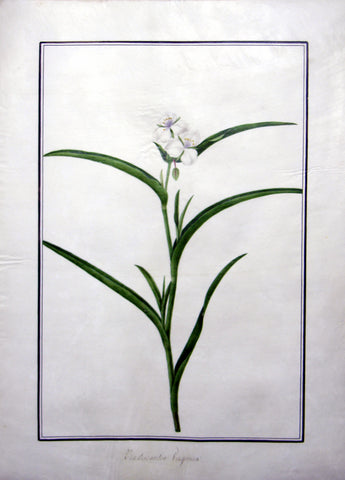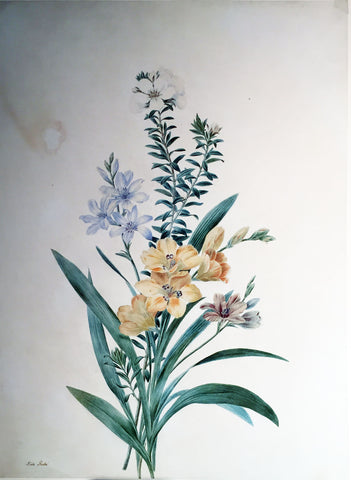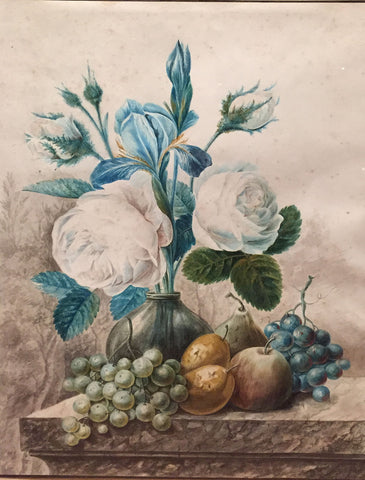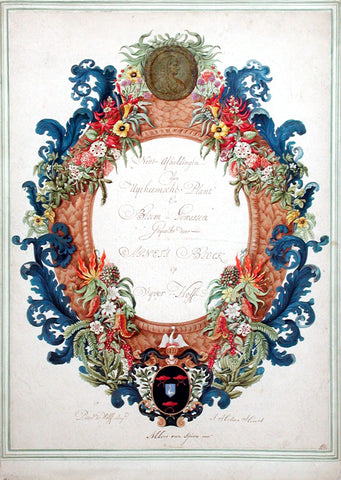
Baldassare Cattrani (Italian, FL. 1776-1810), 24. “Tradescantia Virginia” (Dayflower, Spiderwort)
From a Collection Botannique
Watercolor on vellum, with border, double-ruled in black ink
Titled in ink ‘Tradescantia Virginia’
c. 1809
Sheet size: 20 ½ x 14 ¾ in
Provenance: Acquired from the artist by the Empress Joséphine; Prince Eugène de Beauharnais; by descent through the Dukes of Leuchtenberg; Bibliothèque Eugène de Beauharnais; Braus-Riggenbach and Ulrico Hoepli sale, Zurich, 23 May 1935 (Lot 17); Private Collection; W. Graham Arader III.
Botanists were active in gathering North American plants from the very founding of the New World colonies, and the Tradescant family played a pivotal role in the knowledge and import of American plants to Britain. John Tradescant the elder (b. 1570) was the greatest gardener of his day. He introduced to Britain a number of new, strange, and exotic trees, including the tulip, at his garden near Lambeth Palace, the official residence of the Archbishop of Canterbury.
In 1609, Tradescant provided funds for Captain Samuel Argall to find the shortest route from England to Jamestown, Virginia. Later, in 1616, he was also a shareholder in a plan for a Virginia plantation led by the Captain. Author Mea Allan believes that John Tradescant, the younger went along on the trip and sent plants back. One plant sent back was Spiderwort, which bears his name: Tradescantia virginiana. He named 40 North American plants in his garden-list of 1634 and credited with being the first to grow: the Virginia Creeper (Parthenocissus quinquefolia), Aquilegia canadensis, Aster tradescantii, Rudbeckia laciniata, Tradescantia virginica, and, possibly Robinia pseudo-acacia. It has been said the family also brought back the first lilac, gladioli, lupins, the pomegranate, the hypericum, and many crocuses.
Baldassare Cattrani (Italian, FL. 1776-1810)
Nearly unparalleled in terms of depth and quality, Baldassare Cattrani’s watercolors are masterpieces of the highest order. An opportunity to acquire works by this gifted and as yet shockingly underrated Italian artist should not be overlooked.
Cattrani was Roman by birth and a contemporary of Pierre-Joseph Redouté. Not only did he gain permission to study and paint in Padua’s legendary botanical garden from esteemed directors Giovanni Marsili and Giuseppe Antonio Bonato, but he also won highly prized commissions from Empress Joséphine.
The apex of Cattrani’s magnificent oeuvre are the works painted for Empress Josephine around 1806 when she was greatly expanding the gardens at her estate Malmaison. Scholar Lucia Tongiorgi Tomasi found that Cattrani and other invited artists painted Josephine's magnificent collection of flowers. Pierre-Joseph Redoute was there in 1806, too, preparing his voluminous work Les Liliacees (1802-16).
At the death of the Empress, the Cattrani and Redouté albums were inherited by her son, Prince Eugène de Beauharnais, later Duke of Leuchtenberg (1781-1824). They remained with his descendants until 1935. The Beauharnais collection of books and manuscripts sold at the Braus-Riggenbach and Ulrico Hoepli sale in Zurich, on May 23, 1935. Lot 17 was described as:
“Cattrani, Baldassare. Collection Botannique (Collection of Botany.) Collection of 1640 original watercolors, painted on vellum and representing flowers and plants. Size of leaves: 53.5 x 38 cm. 24 volumes. Painted in 1806. In folios… Magnificent work of botany. Each leaf is framed by a double black net and bears the name of the plant below, in some volumes this has been omitted. The first volume contains several watercolors painted on paper and in general those of this volume have a little suffice by the humidity. The watercolors are executed with great taste and care and the artist was able to fix with his brush the brilliance of the colors and the nuances that we admire in flowers. As the liliacees of Redoute, this work also was painted in Malmaison on the orders of the Empress Josephine.” [Translated]
Redoute’s original liliacees watercolors also appeared in this sale as lot 82.
Based on the dimensions and description in the 1935 catalog and stylistic relationships between known works, it can be deduced that the collection of paintings offered here come from the same vital group of manuscripts commissioned by Josephine and subsequently owned by Beauharnais. Other works from this superb collection can be found at Oak Spring Library, Dumbarton Oaks, and the library of the botanic garden at Padua.
or by email at loricohen@aradergalleries.
We Also Recommend





